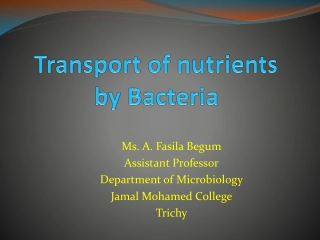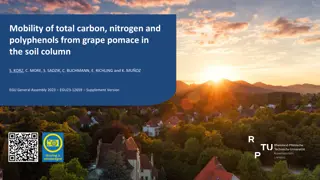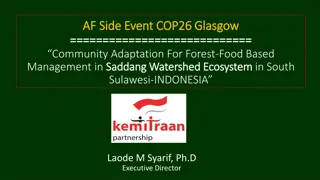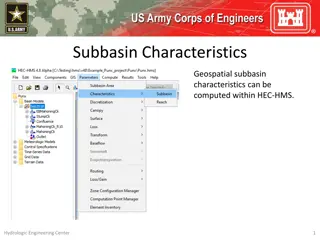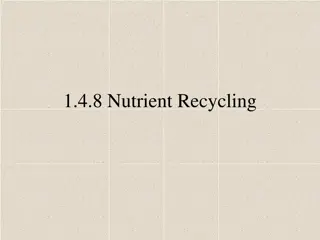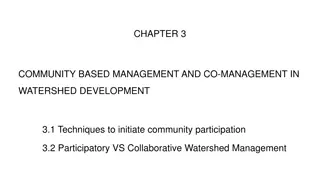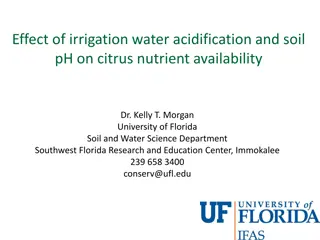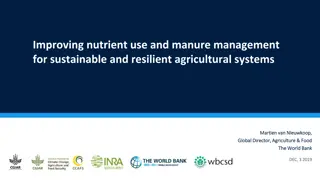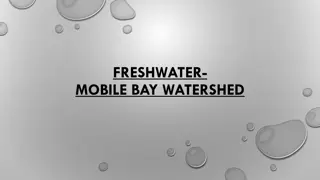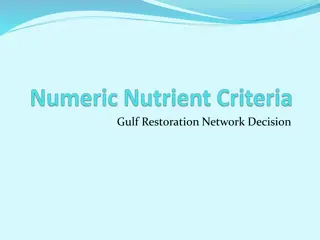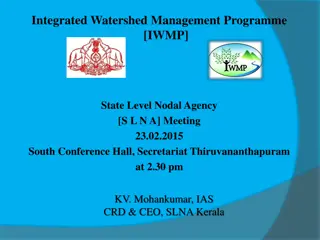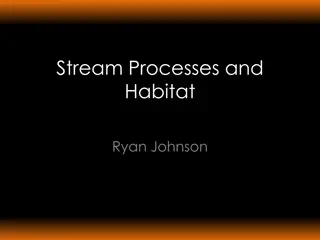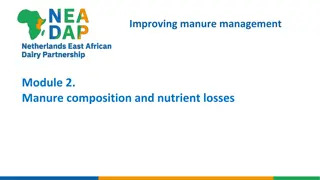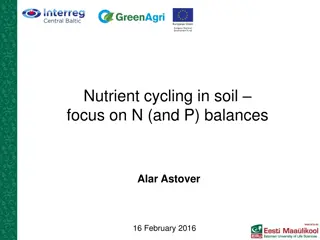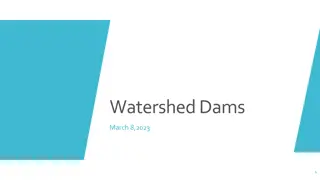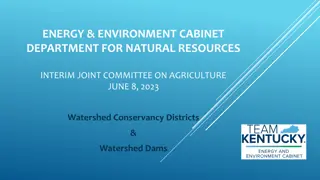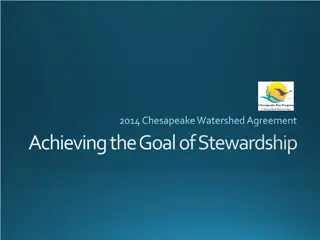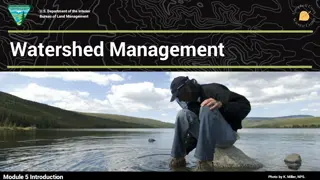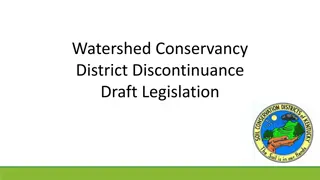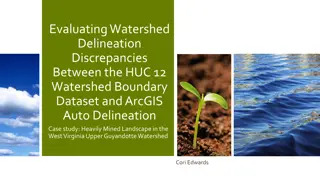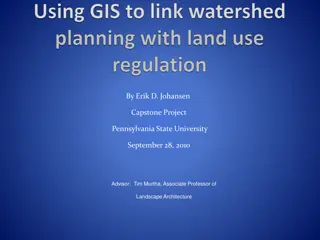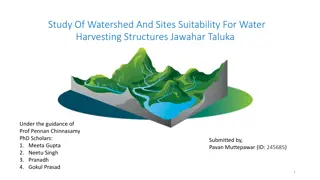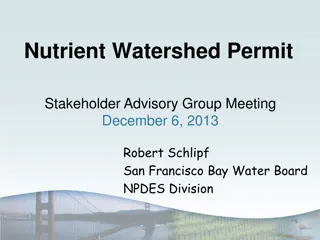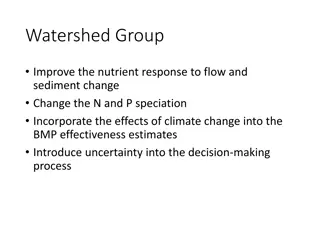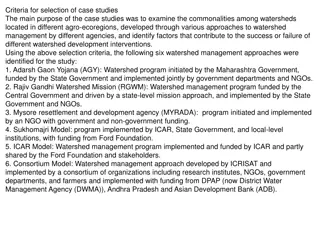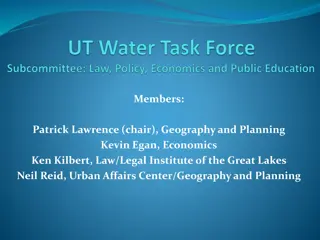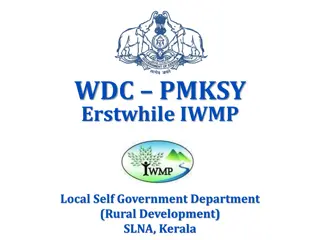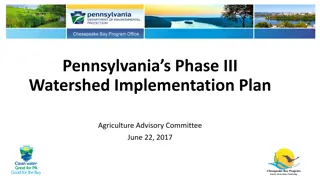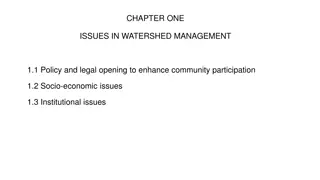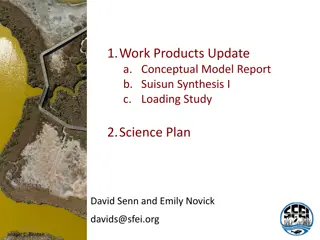Nutrient Uptake in Bacteria: Mechanisms and Factors
The process of nutrient uptake in bacteria, including the role of macronutrients, micronutrients, and environmental factors. Learn about the different mechanisms of nutrient transport and the importance of selective permeability in plasma membranes.
0 views • 25 slides
Stakeholder Engagement in Northern Colorado Water
Explore stakeholder engagement, collaboration, and water management in Northern Colorado, focusing on the Cache la Poudre watershed. Discover the various uses of the watershed, key groups involved in its preservation, and ongoing projects like the Northern Integrated Supply Project. Join the convers
0 views • 14 slides
Grape Pomace Utilization in Soil Nutrient Management Study
Study on the mobility of total carbon, nitrogen, and polyphenols from grape pomace in soil columns, focusing on its relevance as an organic fertilizer rich in nutrients. The research also highlights the industrial potential of grape pomace, nutrient mobility between varieties, and methods used for c
1 views • 14 slides
Enhancing Community Resilience in South Sulawesi: A Sustainable Approach to Climate Adaptation
Empowering communities in the Saddang Watershed Ecosystem, South Sulawesi, Indonesia, to enhance their resilience against climate change. Projects focus on forest-food management, urban climate solutions, coastal community adaptation, and indigenous watershed governance. The initiative aims to stren
4 views • 8 slides
Understanding Subbasin Characteristics in HEC-HMS
Subbasin characteristics play a crucial role in hydrological modeling within HEC-HMS. Before computing these characteristics, the basin model must have georeferenced subbasins in the GIS. Various parameters such as basin slope, relief, elongation ratio, drainage density, and flowpath lengths and slo
0 views • 13 slides
Nutrient Recycling in Ecosystems
Nutrient recycling in ecosystems involves the continuous breakdown and exchange of elements between living and non-living components, ensuring sustainability and no long-term drain on Earth's nutrients. This process includes decomposition of organic material by bacteria and fungi, uptake of nutrient
1 views • 23 slides
Community-Based Management in Watershed Development
Techniques to initiate community participation in watershed management are crucial for sustainable development. Scholars classify participation levels into different categories, highlighting the importance of ideological motivation and voluntary engagement. The shift from direct intervention to part
0 views • 28 slides
Understanding Citrus Nutrient Availability in Relation to Soil pH and Irrigation Water Acidification
This research by Dr. Kelly T. Morgan from the University of Florida explores the impact of soil pH, irrigation water acidification, and nutrient recommendations on citrus trees affected by HLB disease. The study examines the availability of key nutrients such as Mn and Zn, the effects of different s
0 views • 23 slides
Enhancing Nutrient Efficiency in Agriculture for Sustainable Systems
Improved nutrient use and manure management are crucial for sustainable agricultural systems. Efforts to increase nutrient efficiency through better practices can help reduce emissions and aquatic pollution. Public awareness, policy realignment, and soil data quality enhancements are key areas for p
0 views • 14 slides
Mechanisms of Nutrient Uptake by Microbial Cells
Nutrient uptake by microbial cells involves various transport mechanisms such as passive diffusion, facilitated diffusion, active transport, and group translocation. These mechanisms ensure the specific acquisition of required nutrients by the cell through the selectively permeable plasma membrane.
3 views • 15 slides
Understanding Nutrient Pollution and Its Impact on the Environment
Nutrient pollution, characterized by the excess input of nitrogen and phosphorus into water and air, is a significant environmental issue with far-reaching consequences. It can lead to toxic algae blooms, dead zones, economic losses, and adverse effects on human health. The causes of nutrient pollut
2 views • 11 slides
Understanding USDA Watershed Programs for Local Communities
USDA Watershed Programs offer assistance in addressing natural resource issues such as flood control, repairing flood damages, and rehabilitating flood control dams. The three major components - Emergency Watershed Program (EWP), Watershed Protection and Flood Control Program (WPFO), and Watershed R
0 views • 15 slides
European Standards for Plant Biostimulants Development
The European Committee for Standardization (CEN) plays a crucial role in developing European standards for plant biostimulants, focusing on improving plant nutrition processes independently of nutrient content. The CEN/TC.455 committee is responsible for creating standards supporting the EU Fertilis
2 views • 5 slides
Exploring the Freshwater Mobile Bay Watershed
The Mobile Bay Watershed covers a vast area across multiple states, with various rivers and water bodies interconnected through a network of tributaries. Major Alabama rivers, including the Mobile River and the Tombigbee River, flow through this watershed, supporting diverse ecosystems. However, env
0 views • 8 slides
Chesapeake Bay Program Watershed Model Overview
The Chesapeake Bay Program's Watershed Model, presented to STAC in December 2019, provides insights on long-term average pollutant loads and land use dynamics in the Chesapeake Bay watershed. The model incorporates inputs such as land use acres, BMPs, and delivery mechanisms to estimate pollutant lo
0 views • 41 slides
Nutrient Criteria Development Plan for High Rock Lake Summary Update
Nutrient Criteria Development in North Carolina has evolved through various stages since 2001, with the key milestones being the development of the Nutrient Criteria Implementation Plan in 2004 and the Nutrient Criteria Development Plan in 2014. The plan aims to link nutrient concentrations with the
0 views • 8 slides
Iowa Nutrient Pollution Control Measures and Strategies
Gulf Restoration Network Decision, sources of Nutrients Nitrogen (N) and Phosphorus (P), impacts of Nutrient Pollution leading to Algae Blooms and Gulf Hypoxia (Dead Zone), measures to reduce Non-Point Source (NPS) contamination, EPA's current strategy, and Iowa's approach with its Nutrient Reductio
0 views • 20 slides
Integrated Watershed Management Programme State Level Nodal Agency Meeting Report
The State Level Nodal Agency meeting for the Integrated Watershed Management Programme was held on 23rd February 2015 in Thiruvananthapuram, where various agenda items were discussed, including confirmation of previous meeting minutes, action taken reports, project approvals, and resolving project d
0 views • 54 slides
Understanding Watershed Processes and Habitat Impact
Explore the intricate relationship between stream processes, watershed factors, and habitat effects on local wildlife. Learn how climate, geology, soil, vegetation, water, and land use play crucial roles in shaping ecosystems. Discover the importance of maintaining a healthy vegetative community for
0 views • 27 slides
Factors Influencing Watershed Management Explained by Mr. Anil Swami
Mr. Anil Swami, an Assistant Professor specializing in Rainfed Agriculture & Watershed Management, discusses the factors affecting watershed management. These factors are categorized into watershed characteristics, climatic characteristics, land use patterns, social status, and organization. Watersh
0 views • 18 slides
Elk Creek Wood Replacement Project Overview
This project, led by the Oregon Watershed Enhancement Board in 2009 and documented by Katie Halvorson, focuses on the replacement of wood structures in Elk Creek to enhance watershed function and habitat complexity for juvenile coho salmon. By addressing the lack of large wood, the initiative aims t
0 views • 20 slides
Understanding Manure Management: Compositions, Nutrient Losses, and Factors
Explore the complexities of manure management by delving into manure compositions, nutrient losses, and the various factors influencing the quality and quantity of manure. Learn about the impact of animal species, diets, and management practices on manure characteristics, as well as strategies to mi
0 views • 29 slides
Understanding Nutrient Cycling in Soil for Sustainable Agriculture
Explore the intricate processes of nutrient cycling in soil, with a focus on nitrogen (N) and phosphorus (P) balances. Discover the various inputs and outputs considered within different scales, from field to country level. Gain insights into the importance of interpreting data correctly and the imp
0 views • 22 slides
Watershed Dams Rehabilitation Program in Kentucky
The Watershed Dams Rehabilitation Program in Kentucky aims to address the critical need for rehabilitating high hazard dams to ensure public safety and prevent economic damage. With funds allocated for grant programs and local sponsor matches, the initiative targets key priority dams identified by t
0 views • 8 slides
Watershed Conservation and Dam Rehabilitation Initiatives Overview
Explore the functions and responsibilities of Watershed Conservancy Districts in maintaining watershed dams, the funding mechanisms for dam rehabilitation projects, and the prioritized dam rehabilitation initiatives in Kentucky. Learn about the Watershed Dam Fund and its role in supporting the rehab
0 views • 8 slides
Achieving the Goal of Stewardship in the Chesapeake Watershed Agreement
The Chesapeake Watershed Agreement aims to increase the number and diversity of local citizen stewards and local governments supporting conservation and restoration activities for healthy local streams, rivers, and the Chesapeake Bay. Recognizing the importance of local involvement, citizen stewards
0 views • 8 slides
Understanding Watershed Management: Balancing Needs and Resources
Exploring the importance of watersheds in providing natural resources, the consequences of human modifications, and how communities strive to balance human needs with protecting watershed health. This module delves into the sources of community essentials like water, electricity, and heat, emphasizi
1 views • 12 slides
New Procedure for Watershed Conservancy District Discontinuance
A draft legislation proposes a new procedure for discontinuing inactive Watershed Conservancy District boards. Key points include criteria for initiating discontinuance, public notification requirements, voting procedures, and provisions for district boundaries and responsibilities. The legislation
0 views • 6 slides
Evaluating Watershed Delineation Discrepancies in West Virginia
This case study explores differences between NRCS Watershed Boundary Dataset and ArcGIS auto delineation in the Upper Guyandotte Watershed in West Virginia. The project aims to quantify discrepancies, analyze landscape characteristics, examine mining impacts, and assess the variations' effects on hy
0 views • 18 slides
Sustainable Watershed Planning in Stevens County, Washington
The Colville River watershed, known as WRIA 59, is the focus of sustainable watershed planning in Stevens County, Washington. The planning aims to address current and future water needs while protecting and enhancing the water resources within the area. Regulations around water rights, land use, and
1 views • 19 slides
Study of Watershed and Sites Suitability for Water Harvesting in Jawhar Taluka
This project aims to address water scarcity in Jawhar Taluka by studying watershed characteristics and identifying suitable sites for water harvesting structures. The methodology includes DEM analysis using QGIS Grass, watershed delineation, stream extraction, and site suitability assessment based o
0 views • 4 slides
Nutrient Watershed Permit Stakeholder Advisory Group Meeting Overview
The Nutrient Watershed Permit Stakeholder Advisory Group Meeting on December 6, 2013, discussed permit components, effluent monitoring, annual reporting, treatment optimization, nutrient studies, monitoring, reporting, support for nutrient studies, treatment plant optimization, and permit timeline.
0 views • 6 slides
Enhancing Watershed Nutrient Response and Climate Resilience
The Watershed Group aims to enhance nutrient response to flow and sediment changes, improve N and P speciation, and integrate climate change effects into BMP effectiveness estimates. Strategies include spatially varying N relationships, investigating WWTPs and stormwater systems, and reviewing speci
0 views • 7 slides
Analysis of Different Watershed Management Approaches in Various Agro-Ecoregions
This study examines six different watershed management approaches implemented in diverse agro-ecoregions, focusing on the commonalities, success, and failures of interventions. The case study of Adarsh Gaon Yojana (AGY) in Maharashtra highlights the principles and approach towards sustainable villag
0 views • 13 slides
Watershed Management Research Projects in Maumee Watershed
Explore five key research tasks focusing on policies, practices, and impacts concerning nutrient loading into Lake Erie from the Maumee Watershed. Projects include examining CAFOs and CAFFs, declaring the Maumee a distressed watershed, regulating nutrients on farmland, addressing residential lawn fe
0 views • 6 slides
Progress Review Meeting for PMKSY Watershed Projects - Financial Updates and Project Status Assessment
The review meeting held on 10/06/2016 at the Government Guest House in EKM discussed the financial progress and project status of PMKSY Watershed Projects in various districts including Kasargode, Kannur, Kozhikode, Malappuram, Palakkadu, and Wayanadu. The detailed analysis included the project cost
0 views • 64 slides
Watershed Development Programme in Kerala: A Comprehensive Overview
The Watershed Development Programme in Kerala underwent significant transformations over the years, evolving from the Integrated Watershed Management Programme to its current form under the Pradhan Mantri Krishi Sinchayee Yojana. The program's implementation involves various institutional mechanisms
0 views • 43 slides
Pennsylvania's Phase III Watershed Implementation Plan
Pennsylvania's Phase III Watershed Implementation Plan focuses on reducing nitrogen, phosphorus, and sediment loading to meet Chesapeake Bay Total Maximum Daily Load requirements by 2025. The plan involves various sectors like agriculture, urban runoff, and forest areas to achieve necessary reductio
0 views • 30 slides
Issues in Watershed Management: Policy, Legal, and Community Participation
Policy and legal frameworks play a crucial role in enhancing community participation in watershed management. Understanding policy impacts, participatory processes, and implementation strategies are key for effective management planning. Definitions of policy, its components, and what it is not are
0 views • 81 slides
Nutrient Conceptual Model Review Summary
Comments and feedback on a Nutrient Conceptual Model report include suggestions to address issues related to eutrophication concepts, nutrient stoichiometry, community composition, and nutrient reduction goals. Recommendations also focus on incorporating flushing/residence time discussions, predicti
0 views • 9 slides
